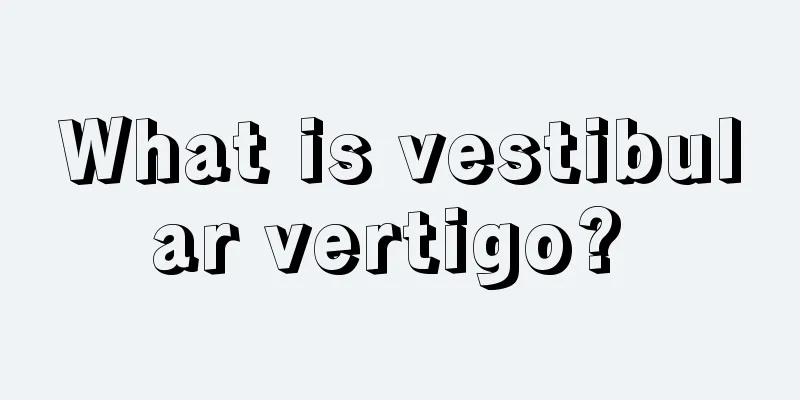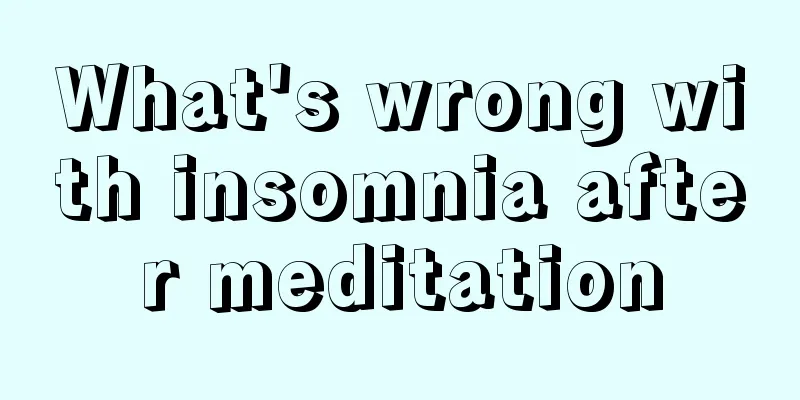What is vestibular vertigo?

|
Vestibular vertigo is a common disease in the past 20 years. The human vestibule is a sensory organ around the ear. Vestibular dysfunction occurs because of organ problems. In order to prevent the occurrence of such diseases, we must adjust and repair them through appropriate methods to prevent vestibular vertigo from causing dizziness and coma, and severe cases can cause respiratory disorders. Vestibular vertigo causes problems with the patient's perception of position and auditory system, making it difficult for the patient to hear clearly. The patient often feels noise near the window or ears, but has no feeling for some real noises in life. He often feels dizzy, weak, and tired all over. 1. What is the human vestibule? The vestibule is the main peripheral sensory organ of the human body's balance system and is located in the petrous part of the temporal bone of the skull. The human ear is divided into the outer ear, middle ear and inner ear (the inner ear is also called the "labyrinth"). The vestibule is located in the inner ear and is one of the inner ear organs. It consists of three semicircular canals, the saccule and the utricle. It is closely connected to the cochlea and is collectively called the auditory organ. The vestibular organ is small and complex, with a soft tube inside a winding hard tube. The semicircular canals, the saccule, and the utricle are also filled with a fluid called endolymph. The vestibular organs have special anatomical structures and functional characteristics. 2. What is the function of the vestibular receptors? The vestibule and cochlea of the inner ear are collectively called the organs of position and hearing. As the name suggests, they are responsible for sensing position and hearing. The vestibule senses the spatial position of the human body, while the latter is responsible for hearing. The three semicircular canals of the vestibule sense the angular acceleration of the body's rotation, while the saccule and utricle sense linear acceleration. For example, even if you close your eyes and don't look out the window while sitting in a moving car, you can still sense the car's acceleration, deceleration or turning. Another example is the feeling of rising and falling when riding in an elevator. These are all sensed by the semicircular canals and otolith organs. The vestibular receptors sense the position of the human body in space and its position changes, and transmit this information to the central nervous system, which mainly produces two physiological effects: on the one hand, it adjusts the changed position and posture of the human body to maintain the body's balance; on the other hand, it participates in regulating eye movements to enable the human body to maintain clear vision during changes in body position and movement. Therefore, it plays an important role in maintaining our postural balance and clear vision. 3. What is the relationship between vestibular function and vertigo? Vertigo is a motor or positional hallucination, which is a conflict between pathological or physiological positional stimulation in the body and the higher sensory centers of the brain. Clinical vertigo is a manifestation of dysfunction of the human body's balance system, including the patient's sense of rotation or the surrounding scenery's rotation, swaying, floating, rising and falling, and tilting. However, symptoms such as heaviness in the head, dizziness and fainting do not fall into the category of vertigo. The human body's balance system is also composed of five links: receptors, afferent nerves, balance centers, efferent nerves and effectors. The vestibule of the inner ear is the main nerve ending receptor organ of the human body's balance system (followed by vision and proprioceptors). If the impulse transmitted to the central nervous system by any one of the three receptors is inconsistent with the impulse transmitted by the other two receptors, or if the information transmitted by the vestibules of the inner ears on both sides is asymmetric, vertigo and imbalance symptoms will occur. On the other hand, because the vestibular nervous system of the inner ear is the main system for maintaining the body's balance function and has extensive connections with other systems in the body, its own diseases or diseases of other systems involving the vestibular system can cause dizziness. Therefore, vertigo is mostly caused by the incoordination of the vestibular system of the inner ear, accounting for about 70% of vertigo cases. For a long time, although there has been no unified definition of vertigo among various disciplines and schools of medicine, the definitions are similar in principle, namely: vertigo is a motion illusion caused by the body's spatial orientation recognition disorder. When vertigo occurs, the patient suddenly feels that he or she or the surrounding objects are rotating or swaying in a certain direction, and dares not open her eyes; she experiences imbalances such as unsteady walking or standing, and leaning to one side; she may have varying degrees of autonomic nervous system symptoms such as nausea, vomiting, pale complexion, cold sweats, etc.; at this time, the patient's eyes may be seen jumping horizontally to the left or right. This is what doctors often call nystagmus, or nystagmus for short. On the other hand, vertigo is an extremely common feeling for humans and is not necessarily a disease that requires treatment. Because broadly speaking, vertigo can be divided into pleasure vertigo and discomfort vertigo. Pleasure vertigo mainly affects healthy people, such as people participating in stimulating recreational activities (rotating airplanes, wooden horses, boats, etc.) to achieve a temporary sense of vertigo, getting drunk in moderation, and taking certain "special medicines"; vertigo caused by various pathological factors that makes the majority of patients feel uncomfortable is the object of medical research, and is also the topic we want to talk about. 4. Are dizziness and vertigo the same thing? Vertigo and dizziness are not the same thing. Although patients often use the terms dizziness and vertigo interchangeably when describing their condition, they are medically different. First of all, the causes are different: vertigo is mainly a special symptom caused by the inner ear vestibular balance system and its related diseases, while the feeling of dizziness and lightheadedness caused by cerebrovascular, hypertension and other diseases is considered dizziness. In addition, blacking out and confusion caused by orthostatic hypotension are not considered vertigo. Secondly, the symptoms are different: vertigo refers to the patient feeling dizzy or spinning or falling down, like sitting in a boat or a car. When the disease occurs, the patient closes his eyes tightly and holds the bed with both hands for fear of falling off the bed. It is accompanied by nausea and vomiting. In severe cases, the patient vomits bitter water, has abdominal pain and diarrhea, is pale and has cold sweats, etc. Although the symptoms are serious, the patients are conscious. Some patients may also feel that the surrounding scenery is swaying left and right, or floating up and down. The above symptoms are called vertigo, which is a symptom unique to inner ear-vestibular system diseases. Dizziness refers to the feeling of lightheadedness and dizziness that the patient feels when the disease occurs. For example, the feeling of hypertension patients when they have an attack, the feeling of dizziness due to lack of sleep or excessive drinking should be called dizziness; and those who have been squatting or sitting for a long time and suddenly stand up and feel black eyes, golden stars, unstable standing or temporary loss of consciousness for some reason, suddenly fall down, etc., this is not vertigo but fainting. Dizziness and syncope are both caused by various diseases related to the central nervous system and are fundamentally different from inner ear vertigo. 5. Why do we need to check vestibular function when we have vertigo? What are the vestibular tests? Because vertigo is mostly caused by lesions in the vestibular system of the inner ear, when patients with vertigo see a doctor, doctors often first ask them to undergo vestibular function tests in order to analyze and find the cause of the vertigo and adopt appropriate treatment plans. The vestibular organ is small and complex, growing in the petrous part of the temporal bone of the skull. Its morphology cannot be examined from a morphological perspective, like the chest and abdominal organs, through sight, touch, tapping, hearing or ultrasound, nor can its functional state be examined from an electrophysiological perspective by sticking electrodes on its surface, like examining the heart, directly by recording its potential changes. In addition, the vestibular nervous system is extensively connected with other systems throughout the body, so vestibular function testing is relatively difficult, complex and special. Clinically, its functional status can only be tested indirectly through vestibular reactions. Vestibular response includes three parts: 1. Sensory response (vertigo), 2. Motor response (nystagmus, body tilting and hyperactivity) 3. Autonomic nervous system response (nausea, vomiting, sweating and pale complexion). |
>>: Do you know the dangers of generalized anxiety disorder?
Recommend
Endometrial cancer metastasis cure rate
What is the cure rate of endometrial cancer? Alth...
How to eliminate kidney cyst
Kidney cyst is a very common kidney disease. As w...
Explore the causes of rectal cancer
In life, many people suffer from gastrointestinal...
Will the recurrence rate of nasopharyngeal carcinoma be high after radiotherapy?
Radiotherapy is a common method for treating naso...
How long after a meal is it best to exercise?
It is often said that if you walk a hundred steps...
What to test for gout
Gout is a very common disease in normal times. It...
What should I do if I have persistent diarrhea? You need to know these methods
Diarrhea is also loose stools, which is mainly ma...
How long can targeted drug treatment last for patients with advanced lung cancer?
Lung cancer in the advanced stage generally means...
How long can you live with bone metastasis in the late stage of renal cancer? The answer given may be unexpected
Kidney cancer is prone to metastasis in the late ...
How to use papaya milk to make breasts bigger
With the change of quality of life, people's ...
Urinary dysfunction is usually seen in most cases of prostate cancer
Urinary dysfunction is usually seen in most cases...
What are the causes of prostate cancer?
Prostate cancer mainly occurs in middle-aged and ...
What is the difference between cassava and sweet potato?
In fact, many friends mistakenly distinguish cass...
How to treat kidney cancer metastasized to the liver and lungs? Can kidney cancer metastasized to the liver and lungs be cured?
When kidney cancer metastasizes to the liver and ...
The correct way to wash clothes with lemon water
Drinking some lemon water on a regular basis can ...









